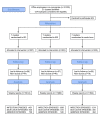Hand washing with soap and water together with behavioural recommendations prevents infections in common work environment: an open cluster-randomized trial
- PMID: 22243622
- PMCID: PMC3296604
- DOI: 10.1186/1745-6215-13-10
Hand washing with soap and water together with behavioural recommendations prevents infections in common work environment: an open cluster-randomized trial
Abstract
Background: Hand hygiene is considered as an important means of infection control. We explored whether guided hand hygiene together with transmission-limiting behaviour reduces infection episodes and lost days of work in a common work environment in an open cluster-randomized 3-arm intervention trial.
Methods: A total of 21 clusters (683 persons) were randomized to implement hand hygiene with soap and water (257 persons), with alcohol-based hand rub (202 persons), or to serve as a control (224 persons). Participants in both intervention arms also received standardized instructions on how to limit the transmission of infections. The intervention period (16 months) included the emergence of the 2009 influenza pandemic and the subsequent national hand hygiene campaign influencing also the control arm.
Results: In the total follow-up period there was a 6.7% reduction of infection episodes in the soap-and water arm (p = 0.04). Before the onset of the anti-pandemic campaign, a statistically significant (p = 0.002) difference in the mean occurrence of infection episodes was observed between the control (6.0 per year) and the soap-and-water arm (5.0 per year) but not between the control and the alcohol-rub arm (5.6 per year). Neither intervention had a decreasing effect on absence from work.
Conclusions: We conclude that intensified hand hygiene using water and soap together with behavioural recommendations can reduce the occurrence of self-reported acute illnesses in common work environment. Surprisingly, the occurrence of reported sick leaves also increased in the soap-and water-arm.
Trial registration: ClinicalTrials.gov: NCT00981877
Source of funding: The Finnish Work Environment Fund and the National Institute for Health and Welfare.
Figures




References
Publication types
MeSH terms
Substances
Associated data
LinkOut - more resources
Full Text Sources
Medical
Research Materials

